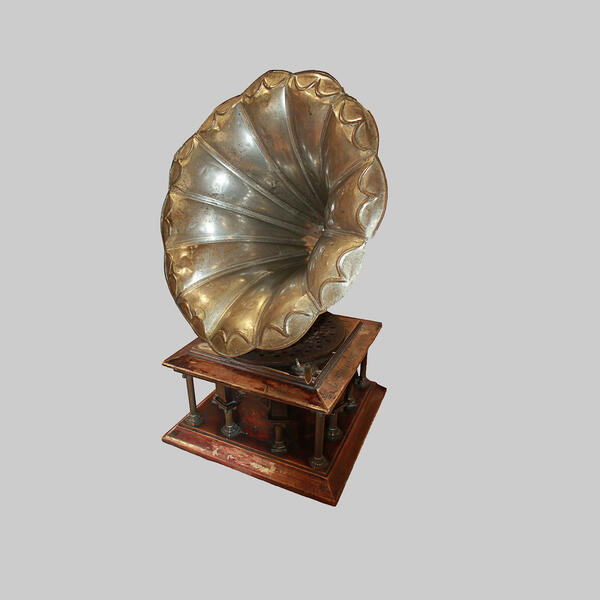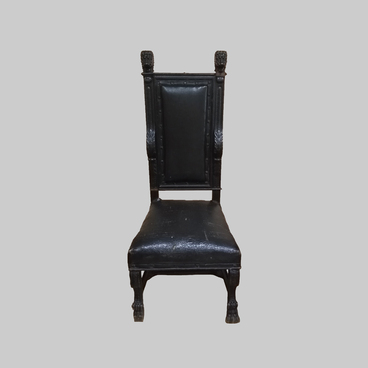Wooden round gramophone from the museum’s collection is made in antique style. Its horn is made of brass, and its body is made of wood. The gramophone is decorated with antique metal columns and arches with slotted carvings. In the round case, there is a spring mechanism that made the pallet with the plate rotate. The sound was extracted by a special folding mechanism, in the center of which was a needle that slid along the plate. The needle was connected to a membrane, which, together with a large pipe, formed a system for amplifying sound to an acceptable volume.
In 1877, the American inventor and entrepreneur Thomas Edison designed a device for mechanical recording and reproduction of sound, i.e. the phonograph. And earlier, in April 1877, almost six months before the first test of the phonograph, the surprisingly gifted scientist Charles Cros who graduated from the University at the age of fourteen sent a description of one device to the Paris Academy of Sciences. He called the device the “paleophone”, i.e. the voice of the past. He described its principle of operation as follows: a needle attached to the membrane draws sound tracks on a rotating glass disk covered with soot. In this case, the needle oscillates in a horizontal plane, while the phonograph moves vertically. After recording the sound, the tracks are optically transferred to a light-sensitive chrome plate. When the plate rotates, the needle extracts the recorded sounds in contact with the membrane. The inventor wanted to enlist financial support to implement the project, but was refused.
It was only ten years later that Charles Cros’ ideas were developed and implemented by Emil Berliner who moved to the United States from Germany at the age of 19. The young man was talented and energetic. While working at first as a handyman, he spent all his free time studying scientific and technical literature. One day he came across the publications of Charles Cros and soon implemented the ideas of his French colleague. The photochemically obtained zinc plate, on which the needle connected to the membrane slid, sang in the best possible way. In 1887, Berliner patented the device, thus calling it a gramophone.
Already at the end of the 19th century, the gramophone became a necessary accessory in the halls and living rooms of wealthy citizens. To keep the guests occupied, the hosts offered to listen to music. But the gramophone had significant drawbacks, such as rapid wear of the record and poor sound quality. In the 1904s and 1906s, improvements to the gramophone made it possible to achieve a fairly clean transmission of the musical sound of pieces, both vocal and instrumental. Gramophone manufacturing has become a powerful independent industry in the United States and Europe, including Russia.
In 1877, the American inventor and entrepreneur Thomas Edison designed a device for mechanical recording and reproduction of sound, i.e. the phonograph. And earlier, in April 1877, almost six months before the first test of the phonograph, the surprisingly gifted scientist Charles Cros who graduated from the University at the age of fourteen sent a description of one device to the Paris Academy of Sciences. He called the device the “paleophone”, i.e. the voice of the past. He described its principle of operation as follows: a needle attached to the membrane draws sound tracks on a rotating glass disk covered with soot. In this case, the needle oscillates in a horizontal plane, while the phonograph moves vertically. After recording the sound, the tracks are optically transferred to a light-sensitive chrome plate. When the plate rotates, the needle extracts the recorded sounds in contact with the membrane. The inventor wanted to enlist financial support to implement the project, but was refused.
It was only ten years later that Charles Cros’ ideas were developed and implemented by Emil Berliner who moved to the United States from Germany at the age of 19. The young man was talented and energetic. While working at first as a handyman, he spent all his free time studying scientific and technical literature. One day he came across the publications of Charles Cros and soon implemented the ideas of his French colleague. The photochemically obtained zinc plate, on which the needle connected to the membrane slid, sang in the best possible way. In 1887, Berliner patented the device, thus calling it a gramophone.
Already at the end of the 19th century, the gramophone became a necessary accessory in the halls and living rooms of wealthy citizens. To keep the guests occupied, the hosts offered to listen to music. But the gramophone had significant drawbacks, such as rapid wear of the record and poor sound quality. In the 1904s and 1906s, improvements to the gramophone made it possible to achieve a fairly clean transmission of the musical sound of pieces, both vocal and instrumental. Gramophone manufacturing has become a powerful independent industry in the United States and Europe, including Russia.



